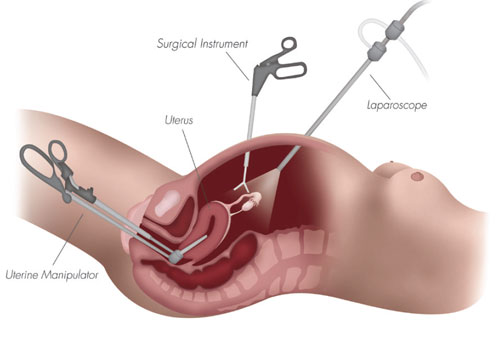Laparoscopic Hysterectomy
Hysterectomy is performed to remove the cyst and fibroids in the uterus. Laparoscopic hysterectomy has advantages such as a quicker recovery period, lower postoperative pain. A small incision in the belly button is made, and a tiny camera is implanted. The surgeon performs the operational surgery while seeing the image from this camera on a TV screen. In the lower abdomen, two or three further microscopic incisions are made. For the removal process, specialized instruments are introduced and employed.

What are the types of hysterectomy?
Supracervical or subtotal hysterectomy -A supracervical or subtotal hysterectomy removes only the upper section of the uterus while leaving the cervix intact.
Total hysterectomy-The entire uterus and cervix are removed
Panhysterectomy– involves the removal of the whole uterus, as well as tissue on the sides of the uterus, the cervix, and the top section of the vagina. In malignancy cases, panhysterectomy is performed.
Who is a candidate for laparoscopic hysterectomy surgery?
A laparoscopic hysterectomy is an option for most individuals undergoing a hysterectomy to treat abnormal uterine bleeding or fibroids.
What steps must be taken before surgery?
The surgeon may request that the patient see their primary care physician before surgery to ensure that there are no medical issues that could interfere with the surgery. Before the day of surgery, there will be a pre-operative appointment that will involve history and physical examination, blood tests, and a visit with a member of the anesthesia department. On the night before surgery, patients should not eat or drink anything after midnight.
What are the benefits of a laparoscopic hysterectomy?
In comparison to a typical abdominal hysterectomy, which involves a 3-6 inch incision, a laparoscopic hysterectomy requires only a few tiny incisions. As a result, less blood is lost, scarring is reduced, and post-operative pain is reduced. A laparoscopic hysterectomy is typically performed as an outpatient treatment, but an abdominal hysterectomy typically necessitates a 2-3 day hospital stay. This laparoscopic treatment has a recovery time of 1-2 weeks. Laparoscopic hysterectomy takes about the same amount of time as an abdominal hysterectomy and has no increased risk. Laparoscopic hysterectomy takes about the same amount of time as an abdominal hysterectomy and has no increased risk.
What may be expected during recovery time?
Patients should expect to take pain relievers for a few days following surgery. We strongly advise patients not to stay in bed. They should get around the house and resume normal activities as soon as they are able. One week after surgery, some women can return to work. Women with physically demanding jobs should stay at home for 2-3 weeks. Within a few weeks of the procedure, women can resume exercise.
Patients undergoing laparoscopic surgery might expect to experience less post-operative pain than those undergoing standard hysterectomy or cesarean section.
Indications for laparoscopic hysterectomy
The indications for laparoscopic hysterectomy are similar to those for traditional hysterectomy. The main indication is abnormal uterine bleeding, which we define as bleeding for more than 7 days with clots and the requirement to use extra protection for more than 2 cycles. Abnormal uterine bleeding can be caused by a variety of conditions, including adenomyosis, fibroids, endometriosis. Before surgery, routine tests must be performed, and medical issues such as infection, hormonal disorder, and so on must be checked.
Recovery time
A laparoscopic hysterectomy is typically performed as an outpatient treatment and has a recovery time of 1-2 weeks.
If you have any symptoms of abnormal vaginal bleeding, Book your appointment with a DR.ANSHUMALA SHUKLA gynecologist today.
